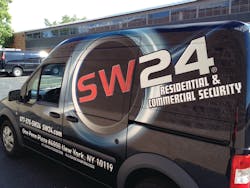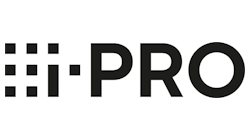Integrator Connection: Security with a Brooklyn Accent
Seeing is believing. It is proof. It is what law enforcement and first responders need to be effective. And it is the heart of SecureWatch 24’s security business. “Video is the direction the whole industry is going,” says SW24 President Desmond Smyth.
Smyth is proud that his company, founded as SecureWatch 24, has focused heavily on video since the turn of this century. Add recent capability with mobile applications — from mobile security video in trucks to license plate recognition — and Smyth is convinced his firm is on the right track.
How it Started
Smyth founded the company after working with the New York Police Department, from which he retired as a detective. His first posting was with the 77th Precinct in Brooklyn, where he began his NYPD career; however, that came after a technology stint with Xerox and time as a Pan Am airline mechanic. Somehow, it all meshed to his position today at the head of a company running the largest public-private video partnership in the nation.
“My brother was the cop,” Smyth says. “For me, it was a job with a paycheck while I found something else.” Twenty years of service later, he finds himself blessed with multiple technology and law-enforcement skill sets that led him to build his own security firm. “Technology is not security,” Smyth warns those who are in love with high-tech. “It is the application of the technology that makes the difference.”
He continues: “Video alone is not the answer. But if you can get it to the district attorney or narcotics detective, then you are making progress.”
Public-Private Partnership
Smyth got his video security start working with apartment building owners. Noting that nobody spends $20 million on a complex hoping to see it deteriorate to a slum, he says that proper deployment of good technology backed by the right applications can make the difference.
As a cop on patrol, he noticed an investment building in the Bronx where the landlord whitewashed the walls and installed video cameras. “He was doing all the right things,” Smyth thought. Two weeks later, the building was covered with graffiti, windows were broken and the cameras were dangling. He could see the landlord’s investment slipping away.
With his background, Smyth knew that the police detectives wanted to make arrests for this kind of unlawful activity. He figured that handing the officer a video of an identified punk selling drugs or kicking in a door, coupled with a signed complaint from the property owner, nearly guaranteed a good arrest. Everyone won. “We supplied video to the NYPD. We cultivated good relationships. We made it easy for them to do their jobs,” Smyth says.
That program, now called the Citywide Safety Initiative (CSI), enables police to get warrants and make arrests after Smyth supplies them with video — with the property owner’s permission. CSI also enables the police to see video in real time.
Today, CSI has ballooned to 28,000 cameras in the New York City area — all monitored and maintained by SW24. They stream more than 6,000 cameras, and the system is currently expanding into Long Island and West Chester, N.Y.; Newark, N.J.; and potentially Boston and Philadelphia. “Police can have access to the system at any time,” Smyth says. “We are the most successful public-private collaboration around.”
Harnessing the Power of Video
SW24 has a long history in video technology. “We were streaming video on cable modems 10 years ago,” Smyth says. By 2005, they had the largest private security network in the area. At that point, he hired his former NYPD partner Gene Dellaglio — whom he affectionately describes as a geeky software guy — as a partner in the company. Together, they built the company.
One major innovation that gave a huge payoff is the company’s ability to stream video directly to the police narcotics division offices. Customers are billed on a per-camera, per-month basis. Word spread among landlords and SecureWatch 24’s business grew.
The key component was the platform for the program. “I don’t want to sell people multiple platforms that do not integrate,” Smyth says, noting that he and Dellaglio built their own VMS platform.
When he started, Smyth says, he knew nothing about the security industry. Rather than design technology, he designed a system to do what he wanted to do. “I wanted software and video that the Supreme Court would be OK with,” he says. That meant software with an audit trail and DVRs on a separate network operations center (NOC) with regulated access to all video. “I wanted no burners…video was only downloaded remotely,” he says. That allowed controlled access.
When he started offering property managers his managed video service in 2003, it was not a popular concept. Even now there are hurdles. “Look up ‘sex and security cameras’ on YouTube,” Smyth challenges. “Every person in all of those videos has a lawsuit against management for improper use.”
Video in Schools
With so many school shootings and lesser violence making headlines, Smyth believes that video could help schools with any life safety issue, from fire to medical emergency to a shooter. Yet, there is resistance to deploying video cameras in the classroom — much of which comes from the teachers who seem worried that someone will snoop in on their classroom routine.
“I’m always looking for new technology,” he says, adding that he loves applications that allow him to cross-purpose technology. So Smyth was thrilled when he happened upon Panasonic’s residential camera with an eyelid. When the eyelid is shut it is impossible to record; however, in an emergency, the camera lens is opened. “The cameras are inexpensive. Any teacher can look at the camera with the eye closed and see that it cannot see anything,” Smyth says.
Another potential dual-purpose use of technology that can serve schools is the panic system used by maids in New York City hotels. As they go about their cleaning duties, maids wear a pendant that will alert security when activated. Security knows which room the maid is servicing and can be there in a flash. “Why not use something similar in schools?” Smyth reasons.
A two-button version could even inform the first responders whether the teacher faces a critical situation or a medical call. Doubly good is the fact that the teacher’s pendant can activate the video camera so the first responders have some idea what they face before they arrive.
License Plate Recognition
When the cost of license plate recognition (LPR) finally moved outside the government realm and became affordable to private business, SW24 hopped on the bandwagon, again leveraging a technology developed for one purpose into an application that serves clients in a different way.
One of the biggest problems with parking garage ownership is all the “side deals” attendants cut with customers. Cash never gets into the till. Monthly customers get off-the-books discounts. The standard loss figure for the industry runs between 20 percent and 30 percent of revenue — LPR changes that.
With LPR, there is no cash changing hands when a car drives onto the lot. Billing is automatic. Parking spaces can be allocated. Better yet, it builds business — an LPR customer can park at any one of the owner’s lots and use the technology seamlessly.
In an application closer to LPR’s original intentions, SW24 is working with Cornell University, on LPR for its parking lots. Here, it is more a matter of assuring that faculty cars are in faculty lots and student cars are in student lots. Campus patrols rove around and, when a violator is spotted by the LPR, a ticket is generated automatically. All the officer needs to do is slap the citation on the windshield.
SW24 is a major vendor of Genetec’s LPR system. “I like the integration,” Smyth says. “I love that everything integrates with video.” There are public safety bonuses, too. LPR systems can be mounted on school buses. When a driver passes a stopped bus, the plate is automatically scanned and a citation issued.
Video Ties it Together
Still, it all ties back to the video system. “I hate selling fear,” Smyth says, although he acknowledges that fear is why the business exists. He will talk about the central station being able to handle the more common instances like fire as opposed to the ultimate horror or a gunman.
In every case, however, he knows how valuable it is to first responders to be able to see the situation in any building or on several floors of the same building before risking their own lives to handle a situation. In fact, he even set up a program to honor first responders and those who defend our security at local NBA games (see “Hooping it Up for Our Heroes” sidebar). With live video feeds, responders will not have to waste time or effort on areas or floors that already are secure. They can see just what the situation is in areas that are at risk.
SW24’s ties to Monitor America’s central station for monitoring. While Smyth does own stock in Monitor America, he says SW24 and Monitor America are two separate entities. This allows one firm to focus on selling systems and the other to provide and contract with anyone who needs true central station services.
As future-looking as he is, Smyth cautions people not to rely on analytics. He is sticking with the tried-and-true. “Look to simple technology that might, just might, do something,” he concludes.
Curt Harler is a technology writer and regular contributor to SD&I magazine. Reach him at [email protected].
.
SIDEBARS
A Closer Look
- Company name: SecureWatch 24 (SW24)
- Website: www.securewatch24.com
- HQ location: New York City
- Principals: Desmond Smyth, president; Gene Dellaglio, principal; John Colgan, EVP; Jay Stuck, EVP and CMO
- Year founded: 2004
- Number of employees: 150
- Residential/Commercial split: 80 percent commercial, 20 residential
- Top technology brands sold: Genetec, Totus, WEY Technologies, Kantech, SW24 VMS software, Inovonics
Hooping it Up for Our Heroes
Earlier this fall, SW24 signed a multi-year contract with the NBA’s Brooklyn Nets, under which SW24 will be a presence both behind the scenes and front-and-center.
During a dedicated timeout at every Nets regular season home game, SW24 will honor a member of the U.S Armed Forces or a New York-area first responder. And at the conclusion of each Nets victory, the team will name one player as the “SW24 Lockdown Defender of the Game.” The player who wins that distinction the most times will be named the SW24 Lockdown Defender of the Year.
Interestingly, Smyth used to patrol the same neighborhood where the Nets stadium is located today.




